#Popillia japonica
Text

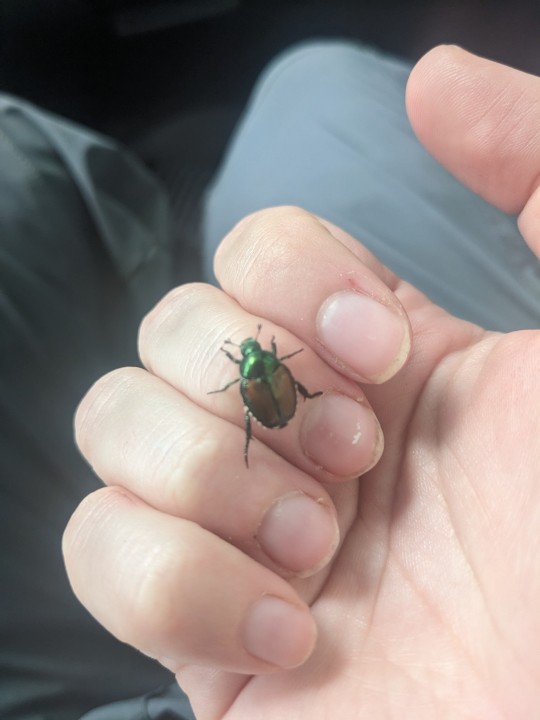
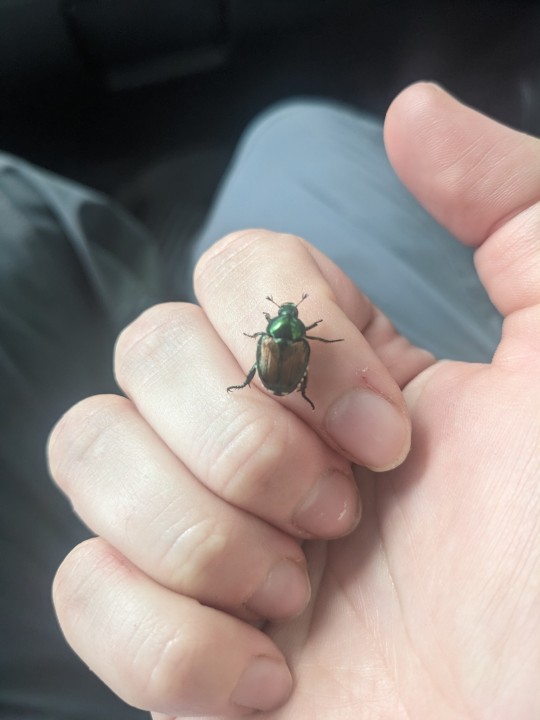
Sweet lil Japanese beetle (Popillia japonica) who tried to hitch hike back to the office with us!
These guys are invasive in North America, first being introduced more than 100 years ago in 1911, and are considered destructive pests for farmers.
Be careful handling them as they apparently can give you a lil prick with their spiked back legs. This guy seemed to like me though, but he did do his defensive stance a couple of times (lifting up their back leg and holding it in the air)
#bugs#bugblr#japanese beetle#Popillia japonica#he did not want to leave my hand#i discovered him as we were driving back from the field#i didnt know what he was until i let him go tho
35 notes
·
View notes
Text
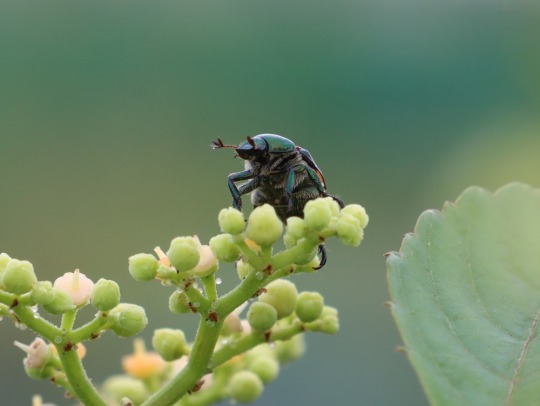
ヤブガラシに来ていたマメコガネ。触角の先が3つに分かれているのがかわいい(7月19日)
Japanese beetle (Popillia japonica)
#Popillia japonica#Japanese beetle#insects#owady#bushkiller#flowers#kwiaty#japan#Poświętnikowate#żukowate#Scarabaeidae
35 notes
·
View notes
Text
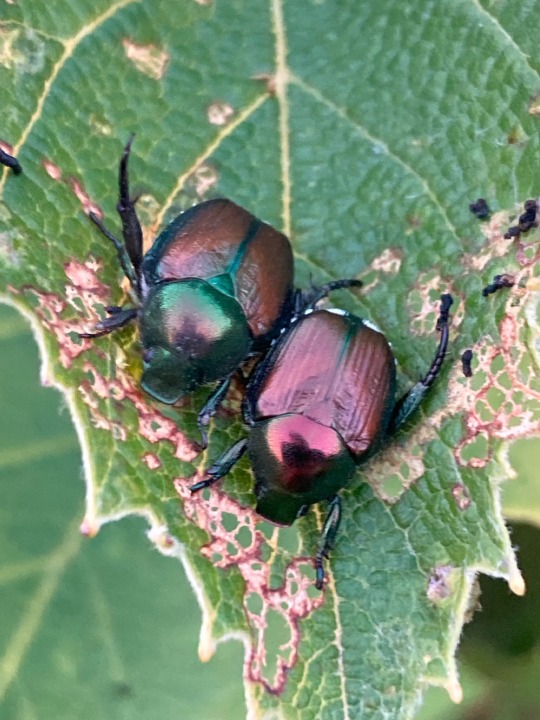
a couple of beetles (p. japonica, i believe) in the process of skeletonizing a grape leaf
#popillia japonica#japanese beetles#bugblr#bug pictures#insects#scarabs#p. japonica#popillia#scarabaeidae#insect photography#bugs
15 notes
·
View notes
Photo

Japanese Beetle
Popillia japonica
Scarabaeidae
Photograph taken on August 28, 2022, at High Park, Toronto, Ontario, Canada.
#wildflowers of southern ontario#Japanese Beetle#beetle#insect#Popillia japonica#Popillia#Scarabaeidae#scarab beetle#High Park#Ontario#Toronto#Canada
5 notes
·
View notes
Text

Popillia japonica
Japanese beetle
Escarabajo japonés
4 of July 2022 — Maryland, USA
A lovely little boi, unfortunately invasive in these parts as well. Was very difficult to get a picture because he was so active haha.
16 notes
·
View notes
Text
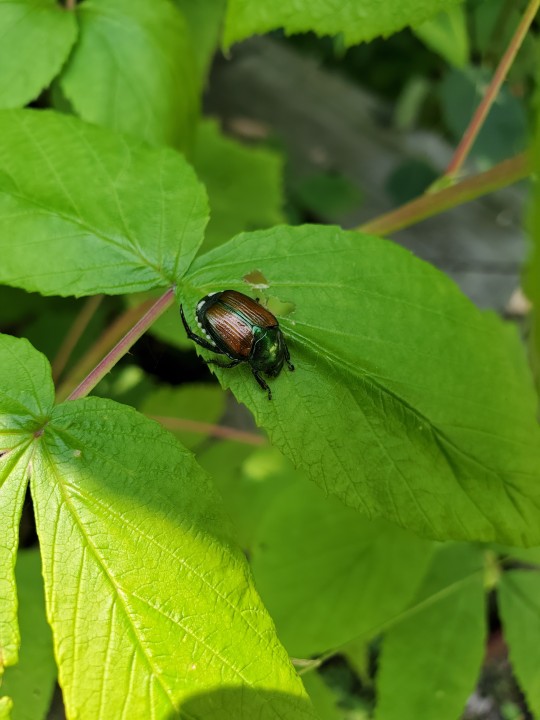
I failed the ecosystem, this Japanese beetle got away from me before I could catch it..!
They're so pretty... I could have kept it :(
#Japanese beetle#Popillia japonica#scarab#beetle#coleoptera#bugblr#invertebrate#bug#insect#invertblr
9 notes
·
View notes
Text

1 note
·
View note
Text

Took a picture of these beetles having a threesome at work because I thought it was funny only to find out later they’re invasive pests lol
#so anyways that’s what Japanese Beetles / Popillia japonica look like#insectblr#bugblr#insects#entomology#beetles
32 notes
·
View notes
Note

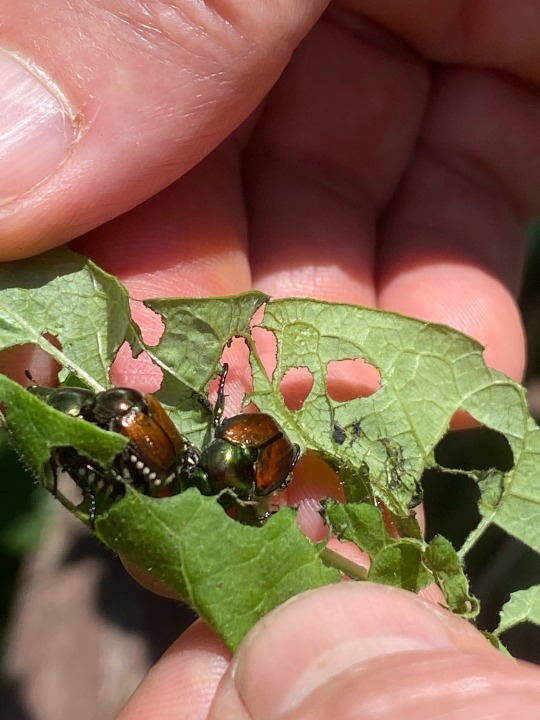

hello! would you please help me identify these beetles that are eating my bean plants?
Popillia japonica, the Japanese beetle. infamous as a polyphagous garden pest in the US
113 notes
·
View notes
Text
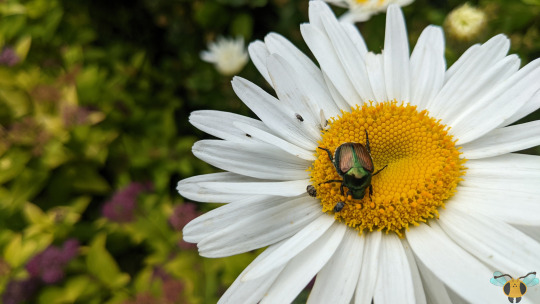




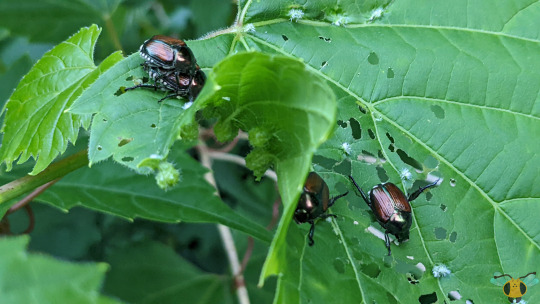
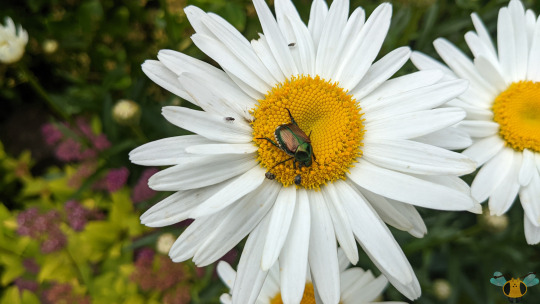
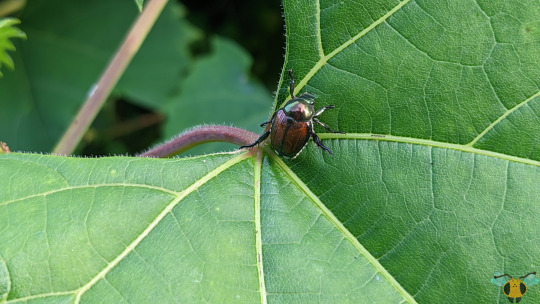


Japanese Beetle - Popillia japonica
After a long absence, these brassy emeralds make a triumphant return to the blog! They've been long overdue, especially since I mentioned in their first post (back in 2019) I would be showing the larger populations that can be found in the neighborhood. Now granted it's not a dramatic increase, but there are many individuals here enjoying the leaves of the suburbs. As can be seen here, these hungry Beetles ignore the leaf's most prominent veins and nibble (somewhat sporadically) on the leaf itself. As generalist feeders, they aren't picky about which plants they land on so long as they are accessible and nutritious. As well, they really love fruits and flowers too! Why, it even seems one individual may even have struck gold with a daisy's pollen...and likely the flower itself if my photo evidence of rose eating remains valid. Given this information, be sure to identify them with certainty if you find them in a flower. The slightly elongated St. John's Wort Beetle is eerily similar at a glance, and yet it's from an entirely different Beetle family.
All the hallmarks of this Scarab Beetle are featured here: leaf skeletonization, iridescent shells and raising their hindlegs to act as a threat display. With regards to the latter, it may not be so readily apparent why the display is a threat. It honestly looks a little silly. However, a vigilant glance at the hindlegs reveals spines just before the midleg. I cannot speak on their strength to pierce or puncture (perhaps a post for a later day) but spines like that are a handy advantage if grabbed from the rear. Speaking of leg observations, looking are the front-most legs can actually allow you to determine if you have a male or female Beetle in your presence. If we use the mating pairs as a reference - since females are mounted by the males - you can actually see that the female Beetles have an elongated, rounded projection jutting out of the end of their tibia! In males, this feature is reduced. Knowing this information, the individual crawling along the daisy is in fact, a female specimen! You can see the tibial projection on her left leg. Do you think the Varied Carpet Beetle next to her noticed?
Pictures were taken on July 1 and 8, 2022 with a Google Pixel 4.
#jonny’s insect catalogue#ontario insect#beetle#japanese beetle#scarab beetle#coleoptera#insect#mating pair#july2022#2022#toronto#nature#entomology#invertebrates
13 notes
·
View notes
Photo

近所のヤブガラシにマメコガネがいました。
#Popillia japonica#マメコガネ#Japanese beetle#昆虫#害虫#insect#owady#ヤブガラシ#Cayratia japonica#烏蘞莓#bushkiller#yabu garashi#Japanese cayratia herb#beetles#japan
21 notes
·
View notes
Text
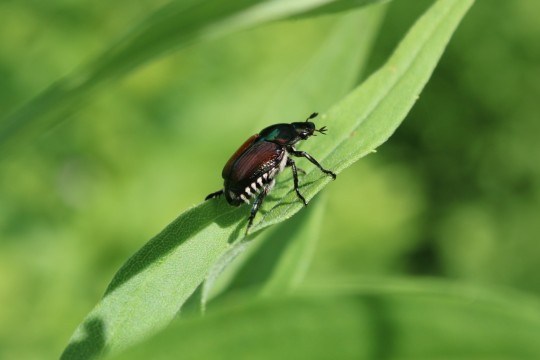

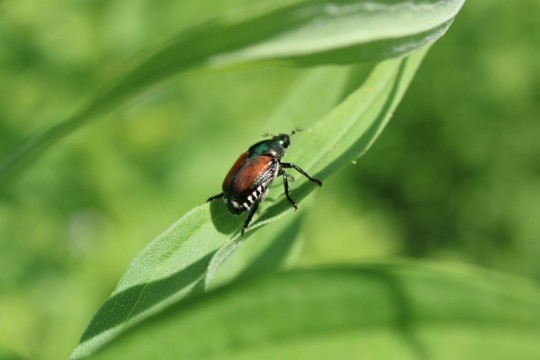

boy look at my insact
(Popillia japonica "Japanese beetle", Northeast US. Do not use or repost my images without explicit permission!)
#bug.txt#bug tag#my pics#beetles#japanese beetles#insects#insect photography#arthropods#scarabaeidae#scarab beetle#bugs#bug photography
23 notes
·
View notes
Text
My Dream Role as an Environmental Interpreter
Growing up, I loved opportunities to go on camping trips to various provincial parks in Ontario. I remember visiting Balsam Lake, Sibbald Point, Six Mile Lake, Killbear and Wasaga Beach Provincial Park. I loved exploring these natural areas and discovering new landscapes and environments within Ontario.

A picture I took at Cape Breton Highlands National Park in Nova Scotia.
My ideal role as an environmental interpreter would be as a park interpreter at a provincial or national park within Canada. My role as park interpreter would involve assisting visitors to explore park trails and swimming areas while providing informational programs safely and respectfully. I would love to run programs such as nature journaling, biodiversity hikes or games such as Wolf Prowl which allows kids to take on roles as animals in an ecosystem. I would also like to help run evening programs that permit visitors to safely explore the trails in the dark which they might not do on their own. As a park interpreter, I would like to focus some programs on establishing people's relationships with nature and sustainability.
The job of an environmental interpreter would require a variety of skills to deliver effective and meaningful interpretation. The skills I first thought of included plant and animal identification and knowledge of ecology, geology, and environmental stewardship. Additional skills in mapping, GPS, and first aid would also be crucial in a role as a park interpreter. Skills in these areas will allow me to be a reliable source of information that visitors can trust with their questions regarding the natural heritage of conservation areas. These areas of knowledge and skills I have listed are essential for environmental interpretation, however, I do not think they are the most important.
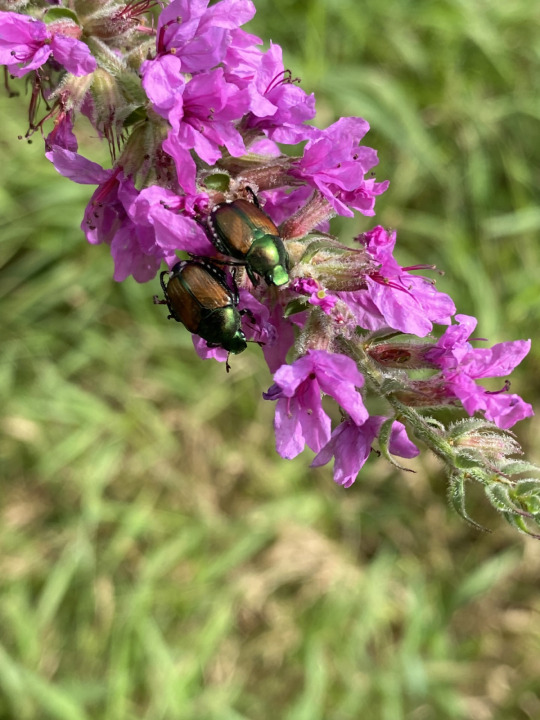
A picture I took of a Japanese beetle (Popillia japonica) on a hike on the Brook Trail in Uxbridge.
Before having the opportunity to work in outdoor education and to read the textbook, Interpreting Cultural and Natural Heritage: For A Better World, I thought knowledge of the environment would be the most important skill to have as an interpreter. However, you could have all the knowledge of nature possible but if you cannot communicate with individuals then you will not be able to effectively share the beauty of nature with others. As described by Beck et al. (2019), communication is the core of cultural and natural interpretation.
In an environmental interpreter role, I would need to be skilled in applying different learning theories and styles to communicate natural surroundings to a diverse group of people. Having the ability to use the Cognitive Development Theory through numerous interpretation forums will allow me to interact with different age groups (Beck et al., 2019). Also, having skills working with multiple intelligences will allow me to connect with a variety of people who learn in different ways (Beck et al., 2019).

A photograph I took in British Columbia at a Natural heritage site.
As an outdoor education intern, I saw many kids with different interests and ways of learning. Some kids connected better to lessons involving games such as Predator-Prey where they got to run around but still learnt about ecosystem functions. Other kids preferred to explore ecosystems through nature journaling or nature photography programs. All kids were able to leave the outdoor education center with new knowledge and new feelings toward the environment through different pathways.
By utilizing my knowledge of the environment with communication and teaching skills I could succeed as an interpreter at a natural heritage site such as provincial or national parks. Communicating my understanding of different environments and sharing my passion for nature would allow me to guide people to form their own connections and ideas of nature.
References
Beck, L., Cable, T. T., & Knudson, D. M. (2019). Interpreting cultural and natural heritage: For A Better World. Sagamore Publishing.
7 notes
·
View notes
Text

Japanese Beetle, Popillia japonica - Invasive to the US
12 notes
·
View notes
Note
I once heard that sometimes ecologists will have beef with a certain species (I’ve read some impassioned anti panda rants) and I was wondering if you have beef with any bug species?
Popillia japonica, they highly invasive and destructive, they eat everything, including kudzu, at such a rate they can kill of most of a forest in under a year, they are a blight on this earth
3 notes
·
View notes
Text
It's Japanese beetle (Popillia japonica) season!!
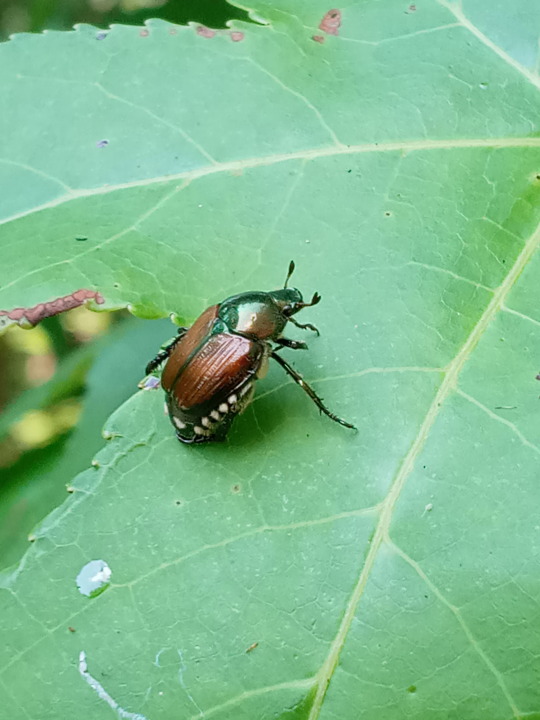
#Beetles#Beetle#scarabaeidae#Scarab beetles#Bugs#Bug#Insects#Insect#Entomology#Arthropods#Photos#Photo#Wasp House Sights#coleoptera
17 notes
·
View notes